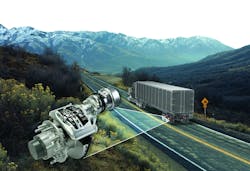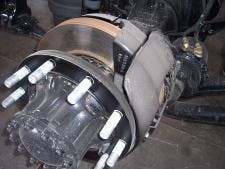When it comes to the stopping power needed to halt a fully loaded tractor-trailer cruising at highway speeds, both air disc brakes (ADBs) and their S-cam drum brake brethren get the job done. But when it comes to consistently delivering that braking performance, ADBs have an edge; unlike drum brakes, they don’t suffer from a “fade” in stopping power after repeated use.
And that edge is becoming more critical as an array of enhanced safety systems (such as a collision mitigation technology) and semi-autonomous truck platforms (such as platooning) are relying on braking consistency to deliver expected performance improvements.
“Look at today’s safety systems and things like platooning and autonomous vehicles,” says Jon Morrison, president of the Americas for Wabco Holdings Inc. “You must look at the foundation those technologies are based upon and that’s the braking system. ADBs can deliver a tremendous amount of consistency in terms of performance and stopping distance, which is something those systems need.
“It’s not just about stopping in 210 to 220 ft.; it’s about better brake torque output, eliminating brake fade, and controlling brake temperature better,” he adds.
Morrison points out that when it comes to operations such as platooning, trucks are operating about 50 ft. apart.
“Brake performance and consistency is going to be critical in making that work safely,” he stresses. “And when you’re talking about trucks that cost $130,000 to $150,000, you need to [decide if you are] going to marginalize on the brakes, especially when you are trying to keep the truck up and running longer with less downtime.”
Nicole Oreskovic, product director for air disc brakes at Bendix Commercial Vehicle Systems, says the big advantage in having ADBs complement truck safety systems is that there is no fade.
“If you are in stop-and-go traffic using the brakes frequently, and then need them in a panic stop situation, you get the same braking performance,” she explains. “Drums may or may not give you that. They will meet the stopping distance rules, but in terms of consistent performance, that will be different.”
The rules of stopping distance
Six years ago, the National Highway Traffic Safety Administration significantly shortened the stopping distance requirements for tractor-trailers. Those rules are as follows:
- A typical three-axle tandem tractor with a gross vehicle weight rating (GVWR) of 59,600 lbs. or less coupled to a trailer and traveling at 60 mph must come to a complete stop in 250 ft. compared to the former 355 ft. stopping standard. This reduced tractor-trailer stopping distance is roughly 30%.
- For heavy severe-service tractors with GVWRs above 70,000 lbs., the stopping-distance requirement is reduced to 310 ft. at the same speed. The caveat is that all “heavy truck tractors” must stop within 235 ft. when loaded to what is termed their “lightly loaded vehicle weight.”
- Two-axle (4×2) tractors and tractors with a GVWR above 59,600 lbs. (6×4) must also meet the 250 ft. at 60 mph rule. So-called heavy severe-service tractors sporting GVWs above 70,000 lbs. are required to meet the shorter stopping distance of 310 ft.
The current ADB adoption rate among Class 6 to 8 vehicles in the U.S. is about 13%, says Oreskovic. “Since we are shipping brakes to [equipment] manufacturers, it is difficult to determine specific usage, but the primary users are over-the-road tractors, trailers and bus applications,” Oreskovic relates.
Bendix is experiencing a significant build rate increase for ADBs this year versus that of 2014, a 40% year-over-year uptick she says is a sign of rapidly growing acceptance of ADBs by the trucking marketplace.
“We see many fleets initially going with ADBs on their steer axles. This lowers the acquisition costs and still enables them to reap many of the benefits of ADBs, often progressing to disc brakes on all wheel positions as their comfort level improves,” Oreskovic points out. “That said, we estimate about half of [commercial] vehicles equipped with disc brakes are using discs on all wheel positions.”
Wabco’s Morrison emphasizes that this steady adoption rate for ADBs should continue but cautions that the percentage rate of adoption really varies between OEMs.
“We think the current market penetration is between 10% and 15% and has been largely in steer axle applications,” he points out. “In turn, we see the trailer ADB market growing significantly over the next few years. There is significant ADB growth in all segments, but it is higher where enhanced safety and maintenance costs are the critical drivers.”
The increase in the overall penetration of ADBs will continue to have a favorable impact on acquisition costs. And this will have the potential to drive major growth in the dry van segment of the trucking market—the sector Morrison says is most sensitive to cost.
“There is still price sensitivity; it’s still a business after all,” he explains. “There is increased cost with ADBs, but fundamentally better braking is the difference, plus longer maintenance intervals, less out-of-service compliance issues, and no negative resale impact.”
To really increase ADB adoption, Morrison thinks ADBs need to be in a $600 to $800 “delta” in terms of additional cost. And he cautions that simply building more ADBs won’t necessarily make them cheaper.
“It’s not scale; volume does not automatically convey lower cost,” Morrison stresses. “It’s about less weight and better integration for ADBs at the wheel end. It’s about optimizing the wheel end with ADB-friendly brackets and hub/rotor interfaces. And OEMs have to commit to that fundamental optimization.”
Bendix’s Oreskovic agrees that the price gap between ADBs and drum brakes is indeed shrinking, but it is a gap that is heavily OEM-dependent. “The premium can run to $2,500 to $5,500, depending on the OEM and truck application,” she adds. “But when you look at the maintenance and time savings at the wheel end, that alters the return on investment calculation.”
Oreskovic stresses that many factors that influence the ROI of ADBs vary based on individual fleet circumstances. “However, longer lining and rotor life, shorter maintenance times, and reduced downtime are key inputs,” she says. “Once the wheels are off, both wheel position [pads] can be changed in under 30 minutes [with ADBs] versus close to two hours for a drum brake [pad] replacement. Plus, no special tools are required.”
Morrison notes that safety compliance is another ROI factor that needs to be carefully considered where ADBs are concerned. ADBs do not need to be adjusted, so this eliminates the opportunity for out-of-adjustment violations. During the 2014 annual Operation Airbrake inspection “blitz” overseen by the Commercial Vehicle Safety Alliance (CVSA), there was in increase in these types of brake violations.
And during that week-long intensive effort—dubbed “Brake Safety Week” and held last Sept. 7-13—inspectors looked at 13,305 brake systems on trucks and buses operating throughout North America. Some 2,162 vehicles were placed out-of-service (OOS) for all brake-related violations, representing 16.2% of vehicles placed OOS, up from 13.5% during the 2013 event. In addition, CVSA stated that the OOS rate for brake adjustments increased to 10.4%, up from 9% in 2013; the OOS rate for brake components reached 9.3%, up from 7.1% in 2013.
“This can be important for driver retention as well,” Morrison says. “Compliance is one of the central value points of ADBs. ADBs don’t suffer from the whole issue of brakes being out of adjustment.
Look at what’s happening with CSA; both fleets and drivers are being scored on vehicle and especially brake condition. Using ADBs means you’re less prone to those kinds of brake violations.”
And from a recruiting/retention perspective, he explains, drivers focused on maintaining clean CSA score sheets will be looking for fleets with ADBs on their trucks, along with electronic stability control, collision mitigation technology, etc. “The driver gets tagged with this [CSA scores] now,” Morrison notes. “The point is that ADBs offer a very good opportunity to reduce the CSA brake inspection factor. They take a safety compliance issue off the table.”
Of drums, discs, and friction materials
Most OEMs met NHTSA’s reduced stopping rules unveiled in 2009 by switching to wider S-cam drum brakes. Their 16.5-in. size and enhanced design refinements dissipated heat more effectively and as a result stopped trucks within a significantly shorter distance than their predecessors.
Yet many fleets also started using ADBs in combination with drum brakes, mainly on tractor steer axles, which can create the potential for compatibility issues, notes John Thompson, sales manager CV-NAFTA at TMD Friction.
“Careful attention must be paid to potential compatibility issues between drum and disc,” he stresses. “In general, linehaul usage compatibility between brakes is not an issue. It’s in more extreme applications, such as heavy haul or mountainous regions, where the differences in brake designs can be accentuated.”
Thompson says transit and refuse fleets are moving more and more to ADBs for safety, more consistent stopping power, performance at higher temperatures, longer life, and faster relines. However, long haul and even some regional fleets are converting to disc for longer life and to help reduce CSA scores.
When considering which type of brake system to spec, one area often overlooked is what kind of friction material will be used, he points out.
He stresses that tribology, which is the science and engineering of interacting surfaces in relative motion and includes the study and application of the principles of friction, lubrication and wear, dictates that the higher the friction, the higher the wear, regardless of air chamber size.
“That’s why tailoring the friction levels of [brake] pads for specific trucking applications can significantly increase pad and rotor life, which reduces maintenance lifecycle costs on commercial vehicles,” he says.
About the Author
Sean Kilcarr
Editor in Chief
Sean Kilcarr is a former longtime FleetOwner senior editor who wrote for the publication from 2000 to 2018. He served as editor-in-chief from 2017 to 2018.

